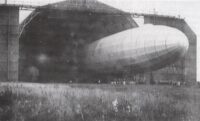In principle, the airship base in Tønder has nothing to do with the stronghold Sicherungsstellung Nord.
The Zeppelins sorted under the Navy while the security position was Army.
However, it occupies such an important place in the area’s military history during World War I that it is included here.
The Zeppelin Base also was secured by the stronghold if an attack was launchwed from Esbjerg.
At the outbreak of the war, the German Navy had only one airship. Zeppelin L 3.
But shortly after the outbreak of the war, the stock of airships increased, and thus also the fleet’s need for hangar capacity.
In September 1914 a hangar plant at Tønder was proposed, and as early as March 1915 the first two hangars were ready.
March 23rd, 1915, the first airship landed on the base, and Parceval PL 25. It was stationed in Tønder for the next 8 months.
April 25th, 1915, the first Zeppelin, L 7, landed on the base.
The base was located a few kilometers north of the city, and was almost self-sufficient with both gas, water, heat, electricity and sewerage system. When it was at the largest it consisted of the following:
3 airships, “Tobias” and “Toni” (1 airship in each) and “Toska” (2 airships) (Two = Tondern / Tønder))
1 aircraft hangar with space for 5 aircraft of the Albatros D III type
1 anchorage for temporary docking of an airship
Radio station for communication with the airships via telegraph.
Bearing transmitter that the airships could navigate.
Lighthouse on the northwest end of the “Tobias” roof
Gas plant and tanker plant of 50,000 cubic meters
Heating plant with lighthouse and central heating for the base.
Sewage system and sewage treatment plant.
2 workshops.
Weather service.
Residential barracks for approx. 600 soldiers.
Underground gas stations: the “Tobias” and “Toni” hangars each had 10,000 liters of storage. The “Toska”
had storage capacity of 30,000 liters.
Railway connected to the Tønder-Tinglev railway line.
Floodlights on rails
The first hangars were “Tobias” and “Toni”, but as the German Navy got more and more Zeppelins, a double hangar was built for Zeppeliners in Tønder. It was completed on January 17th, 1916. A huge building with a length of 242 meters, a width of 73 meters and a height of 42 meters.
It was named TOSKA.
TOSKA was hit by bad luck from the start. Already in November 1915, before the hangar was completely finished, an accident occurred during the gas refilling of Zeppelin L 18, so the airship went up in flames.
In March 1916 Zeppelin L 22 “sailed” the gate to the hall and destroyed the entire front.
In December 1916, when the Zeppelin L 24 was towed into TOSKA, the wind blew the Zeppelin out of control and it hit a lit electric bulb under the hall ceiling. The airship caught fire and both L 24 itself, and Zeppelin L 17 that was also in the hangar burnt out.
It was also “Toska” that was the primary target of the spectacular British air attack that destroyed the Zeppelins L 54 and L 60.
When TOSKA was completed, the construction of a gas plant started southeast of the halls. The Zeppelins were major consumers of hydrogen, and after the completion of Toska, the need was great. The existing gas plant was expanded to a capacity of 8000 m3 hydrogen per day. At the same time, tank plants with a total capacity of 56,000 m3 were constructed both underground and above ground. The hydrogen was carried out to the airship halls via underground pipes.
However, this was far from enough, and the base had to be further equipped with railway facilities that could ensure the supply of hydrogen on specially built railway cars from other plants.
A group of 5 Albatros D III fighter jets had been added to the base for close-air defense. A very modern aeroplane from 1916. This modern material shows how important the base was considered.
For these aircraft, a hangar was built at the southern end of the base. 78 m long, 12 m high and 25 m wide.
The runway was laid in front of the hangar. It was a very primitive grass course that was also poorly planned. As a result, most of the aircraft failed during takeoff or landing. The base fighter defense was therefore abandoned and the last aircraft left Tønder on March 6, 1918.
Therefore, the English only encountered scattered FLAK (Flugabwehrkanone) and small arms fire when they attacked the base in 1918.
The gas plant
Pictures form the Zeppelin Base 2012






